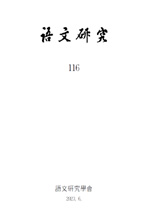- 영문명
- The Confucian Norms and Transgressive Narratives in the ‘Buddhist Nuns’ and ‘Female Shamans’ Sections of the Jinbeolhuigoseokpyeon
- 발행기관
- 어문연구학회
- 저자명
- 곽미라(Mi-ra Kwak)
- 간행물 정보
- 『어문연구』第125輯, 147~180쪽, 전체 34쪽
- 주제분류
- 어문학 > 한국어와문학
- 파일형태
- 발행일자
- 2025.09.30

국문 초록
본 연구는 19세기 후반에 편찬된 인물지 『진벌휘고속편(震閥彙攷續編)』 제4책의 「여승(女僧)」과 「무녀(巫女)」 편목을 대상으로, 조선후기 유가 지식인이 재현한 여성 종교인의 형상을 유교적 규범과 일탈의 양상 속에서 분석하고자 했다. 조선후기 인물지가 사대부 중심의 서술에서 벗어나 다양한 계층을 포용하는 경향을 보였음에도, 여성 인물은 주로 ‘효’와 ‘열’이라는 유가 덕목을 중심으로 기록되었다. 그러나 『진벌휘고속편』은 여승과 무녀의 행적을 독립 항목으로 편성하여 이들을 규범과 일탈이 교차하는 존재로 재현했다는 점을 주목한 것이다.
먼저, 『진벌휘고속편』 「여승」·「무녀」편의 구성과 기록 방식을 위암본 『진휘속고』와 비교하여 특징적 면모를 파악했다. 두 문헌은 수록 인물과 배열순서, 서술 분량 등에서 대체로 유사했다. 다만 『진벌휘고속편』은 인물의 행위와 사건 전개를 비교적 상세하게 서술하는 반면, 위암본 『진휘속고』는 간결한 문장으로 정리하는 경향을 보였다. 두 문헌간 중복 인물을 제외하고 『진벌휘고속편』에만 수록된 인물은 복동이며, 위암본에 실린 오례와 정효성은 여기에 포함되지 않았다.
다음으로, 「여승」편에 수록된 인물들의 행적을 규범과 일탈의 측면에서 분석했다. 희안·지심·계지는 단종비 정순왕후를 따랐던 사례로, 유교적 충절과 불교적 헌신을 결합한 이상적인 규범의 전형을 구현하고 있었다. 또한, 묘관은 과부로서 절개를 지키고 학문을 닦는 등 유교와 불교의 덕목을 동시에 실천하는 모습으로 기록되었다. 반면 혜명과 영일은 궁궐 출입, 정치 개입 등으로 종교인의 신분적·공간적 경계를 넘어선 일탈 행위를 보였다. 혜명은 ‘요망함’이라는 부정적 프레임 속에 갇혔고, 영일은 적극적인 정치적 영향력을 행사한 인물로 서술되어, 기록자가 부여한 평가의 온도 차를 확인할 수 있다. 특히 영일의 사례는 비난을 넘어 정치적 효용성까지 인정하는 이중적 시각이 드러났다.
마지막으로, 「무녀」편에 나타난 유교적 규범과 일탈의 양상을 살펴보았다. 용안·내은덕·덕비는 단종에 대한 충절을 지켜 무녀의 신분으로도 배향될 수 있었고, 호남 무녀는 지략과 담력을 발휘하여 남편의 목숨을 구하고 정절을 지켰다. 이들은 무녀라는 신분적 한계를 넘어 유교적 덕목을 실천한 모범 사례로서 긍정적으로 평가되었다. 그러나 요무와 막례는 왕비의 죽음에 연루되거나 동성애라는 성적 일탈을 저질러 궁궐 질서를 교란했다는 이유로 ‘요망함’과 ‘위험성’의 담론 속에 포섭되며 부정적으로 서술되었다. 남성 무당인 복동 역시 여성 행세를 하며 궁중 질서를 어지럽힌 죄로 사형에 처해졌다.
이렇게 『진벌휘고속편』은 여성 종교인을 유교적 질서의 경계에서 규범을 따르거나 일탈하는 인물로 대조적으로 기록했다. 특히 여승과 무녀의 행적은 궁중과 민간, 정치와 종교, 신앙과 기만이라는 상반된 가치 영역을 오가며, ‘규범 준수’와 ‘경계 일탈’의 행위를 대비적으로 제시하는 서사 구조를 보인다. 이러한 서사는 단순히 흥미 위주의 기이한 이야기를 모은 것이 아니라, 당대 사회가 비주류 여성 집단인 여승과 무녀를 관리하고 통제하려 했던 정치·사회적 메시지를 담고 있음을 확인할 수 있다. 이상의 논의는 『진벌휘고속편』의 「여승」·「무녀」편을 대상으로 지금까지 시도되지 않았던 연구라는 점에서 의의를 지닌다.
영문 초록
This study examines the “Buddhist Nuns(女僧)” and “Female Shamans(巫女)” sections in Volume 4 of the Jinbeolhuigoseokpyeon(震閥彙攷續編), compiled in the late nineteenth century, analyzing how Confucian literati in late Joseon depicted female religious figures through the dual lenses of normative compliance and deviation. While late Joseon biographical collections show a trend toward including various social strata beyond the yangban elite, female figures were still primarily recorded according to Confucian virtues such as filial piety and chastity. However, the Jinbeol Hwigo Sokpyeon organized Buddhist nuns and female shamans as independent categories, portraying them as complex figures at the intersection of norm and transgression.
First, the structure and recording style of the “Buddhist Nuns” and “Female Shamans” sections are compared with those of the Wiambon edition of the Jinhwisokgo(震彙續攷). While both sources show similarities in the selection, sequence, and length of entries, the Wiambon edition corrects errors and supplements factual details. Notably, the Jinbeol Hwigo Sokpyeon titles the section “Female Shamans(巫女)” to include male shamans, whereas the Wiambon edition uses “Shamans(巫覡)” to clarify the broader scope.
Second, the deeds of Buddhist nuns are analyzed in terms of norms and deviations. Hui-an(希眼), Jisim(智心), and Gyeji(戒智) exemplify ideal norms by combining Confucian loyalty with Buddhist devotion in their allegiance to Queen Jeongsun. Myogwan(妙寬) is portrayed as embodying both Confucian and Buddhist virtues through widow chastity and scholarly cultivation. In contrast, Huimyeong(惠明) and Yeongil (永一) transgress the boundaries of religious identity and space by entering the palace and engaging in political affairs. Huimyeong is framed negatively as “deceitful,” while Yeongil is described as exercising political influence, revealing a dual perspective that acknowledges her utility as well as her transgression.
Third, the norms and deviations in the “Female Shamans” section are examined. Yong-an(龍眼), Nae Eundeok(內隱德), and Deokbi(德非) were enshrined for their loyalty to King Danjong, while the Honam shaman was praised for rescuing her husband through wit and courage, thus upholding chastity. These figures transcended the social limitations of shamans by embodying Confucian virtues. Conversely, Yomu(妖巫) and Mangnye(莫禮) were subsumed under discourses of “deceit” and “danger” for their involvement in the queen’s death or sexual misconduct disrupting palace order. The male shaman Bokdong(福同), who cross-dressed and disrupted palace decorum, was executed.
Thus, Jinbeolhuigoseokpyeon records female religious figures in a contrasting manner, portraying them either as conforming to or deviating from the boundaries of Confucian order. In particular, the deeds of Buddhist nuns and shamans traverse conflicting domains—court and common society, politics and religion, faith and deception—thereby constructing a narrative structure that juxtaposes acts of “norm compliance” and “boundary transgression.” Such narratives were not merely collections of curious anecdotes for entertainment; rather, they reveal the political and social messages of late Joseon society, which sought to monitor and control marginal female groups such as nuns and shamans. This study is significant in that it represents the first scholarly attempt to examine the “Buddhist Nuns” and “Shamans” sections of the Jinbeolhuigoseokpyeon.
목차
1. 머리말
2. 『진벌휘고속편』 「여승」·「무녀」편의 구성과 기록 방식
3. 여승·무녀에게 요구된 사회적 규범과 작품 속 일탈 양상
4. 맺음말
참고문헌
키워드
해당간행물 수록 논문
참고문헌
최근 이용한 논문
교보eBook 첫 방문을 환영 합니다!

신규가입 혜택 지급이 완료 되었습니다.
바로 사용 가능한 교보e캐시 1,000원 (유효기간 7일)
지금 바로 교보eBook의 다양한 콘텐츠를 이용해 보세요!



